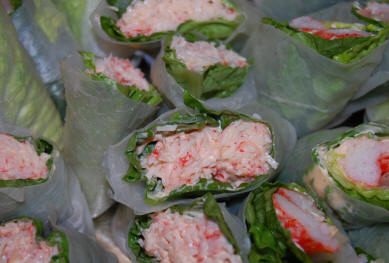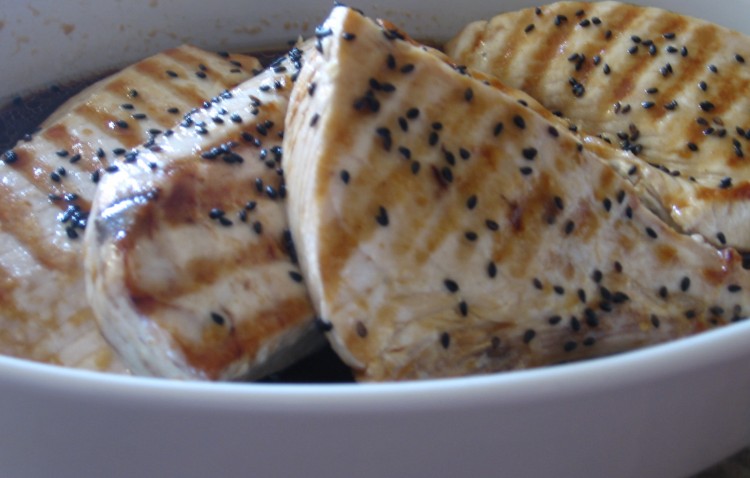
In the interest of something light and fresh, I made sushi spring rolls this evening. This is something I have been making for years, essentially rolls with rice paper and lettuce instead of rice and seaweed. You need: butter lettuce leaves, spring roll wrappers (these are made of rice and are dry and round — kind of clear. You need to soak them before use) and fillings. If you purchase some sashimi grade albacore tuna, which is reasonably priced, and a package of kani kama (fake crab meat set up in pieces for sushi), you’ll be in good shape. Be sure you have a bit of Best Foods/Hellman’s mayo, some Sriracha hot sauce, a few scallions, an English cucumber and a Haas avocado, too. With these things you can make tuna rolls, spicy tuna rolls, tuna and scallion rolls, fake crab rolls, spicy fake crab rolls, California rolls, spicy California rolls, and more.
You’ll need to prep everything first and then set up an assembly line. Separate your lettuce leaves, wash and dry them thoroughly. You can store them in a plastic bag between damp paper towels if you prepare them in advance. Wash/dry/chop the scallions. Peel the cucumber and cut into 3″ X 1/4″ segments. You won’t need to seed an English cucumber, but you will if you use the other kind. Cut the halved avocado into long slices. Take half of your kani kama and pull it apart slightly so it is not so densely packed. This stuff is generally stringy so you will be pulling apart strands. If you get the variety that is solid, which is not as good, then just leave it as-is. Shred the other half and mix with enough mayo to make a non-runny crab salad. Take half of the crab salad and mix in a bit of the Sriracha. You will now have some kani kama, some crab salad and some spicy crab salad. Take your tuna and cut it into 3″ strips of any thickness you like. If you bought a large piece of albacore you should have some trimmings – meaning perfectly good to eat but in scraps. Chop the trim coarsely and mix with a little Sriracha. If you don’t have trim then you can use some of your blocked tuna, of course.
You now have, count ’em, five fillings. Set up an assembly line starting with a large bowl of warm water, about six wet paper towels, and a dinner plate. Then you’ll need a dry board to prepare your rolls, and a sharp knife and clean place to cut them. I use a large board and do the cutting on one corner. Finally, you’ll want a serving plate to place the cut rolls. Place your veggies and fish fillings within easy reach of the board, and be sure to keep the bottle of Sriracha handy in case you want to squeeze some directly into rolls. Have plenty of hand towels nearby. Now take four of the wrappers and submerge in the bowl of water. Let them stay there for about a minute. Lay a wet paper towel on the dinner plate and spread out a soaked wrapper on top of it – being careful not to split or tear it. Then cover with another wet paper towel. Keep layering until you have no more wrappers. Add wrappers to the water and replace in the paper towels (new ones on the bottom of your layers) as you go so you always have soft wrappers ready. Then you will need to do this: take a wrapper and lay it out on your board. Cover the inner 2/3 or so with lettuce leaves so you are placing filling onto the lettuce and not the bare wrapper. Add veggie lengths in the middle and then top with some sliced fish or fish salad so you have sort of a tube shape of fillings. Add scallions – or not. Pretend you are filling a burrito in that you want to wind up with a hefty roll but have enough of the outside of the wrapper available to roll it without any ooze. Then roll it up as you would a burrito: fold in the sides and then tuck the top under the front of the fillings and roll toward you as tightly as you are able. It takes practice to produce a non-floppy roll, but you can always eat your mistakes. Then cut the roll in half at an angle and place on your serving platter. Since all of these fillings go together you can add what you like when creating rolls.
Eat them as soon as you can after they are put together and serve with soy sauce, ginger and wasabi, if you like. Note that I did not include any quantities since I do not know how big you will be making your rolls. For the four of us I generally use about 12 ounces of kani kama and 12 ounces of albacore. If you live near Berkeley you can buy the fish at Tokyo Fish (1220 San Pablo Avenue) or Berkeley Bowl (2020 Oregon Street). They carry large pieces (about a pound or so) of frozen sashimi grade albacore that generally needs only minor trimming of fibrous material. I have rarely had to deal with a bloodline in these hunks of fish – which you always want to trim off and discard. The kani kama will also be available frozen. Buy the frozen fish a day or two in advance and let it thaw out in the fridge. The rest of the stuff can be found at any decent Asian market. Trust me.
Another hint is to keep everything dry. Wet lettuce, for example, will keep softening the wrappers and turn your rolls into mush. Keep moving your wrappers, too – don’t let them sit in the water too long. Even if they feel too firm when you take them out they will be soft enough when you need them because they will be in wet paper towels awhile. If the paper towels dry out, wet them. Wipe your knife off with a kitchen towel between roll cuttings. Finally, don’t yell at me if you feel these instructions are not detailed enough. Instead, just contact me if you want to know more. Believe me when I tell you that these rolls are worth learning how to deal with spring roll wrappers.

